Spatiotemporal Evolution of Fractional Vegetation Cover and Its Response to Climate Change Based on MODIS Data in the Subtropical Region of China
Abstract
:1. Introduction
2. Materials and Methods
2.1. Study Area
2.2. Data Acquisition and Preprocessing
2.3. FVC Estimation Method
2.4. FVC Spatiotemporal Evolution Analysis Method
2.4.1. Determination of the FVC Evolution Trend and Analysis of Its Significance
2.4.2. FVC Spatial Fluctuation Characteristics
2.5. Analysis of Temporal and Spatial Responses of FVC to Climate Change
2.6. Analysis of the Contribution of Climate Factors to FVC Variations
3. Results
3.1. Spatial Distribution Characteristics of the FVC
- (1)
- The distributions of the FVC high-coverage zone and medium-coverage zone were relatively concentrated and broad, and their combined area accounted for more than 70% of the study area. From 2001 to 2018, the overall area of the high-coverage zone showed a significant upward trend, and its areal proportion reached a maximum in 2016 (45.07%). However, the area of the medium-coverage zone showed a significant declining trend, with its areal proportion decreasing from 39.34% in 2001 to 31.28% in 2018 and reaching its minimum in 2016 (31.08%). The variation trends of the medium-coverage zone and high-coverage zone exhibited a certain degree of symmetry. The area of the medium-coverage zone was larger than that of the high-coverage zone from 2001 to 2012, while the area of the high-coverage zone was larger than that of the medium-coverage zone from 2013 to 2018.
- (2)
- The area of the low-to-medium-coverage zone also showed a significant downward trend during the study period, and its areal proportion decreased from 24.37% in 2001 to 14.28% in 2018. The low-to-medium-coverage zone was distributed in strips and blocks around areas of human activity, such as eastern Sichuan Province, eastern Hubei Province, northern and central Hunan Province, eastern Yunnan Province, and northern Jiangxi Province. In terms of the vegetation types in the region, a large proportion of the low-to-medium-coverage zone was cultivated land.
- (3)
- As a whole, the area of the low-coverage zone showed a slight downward trend, and its areal proportion decreased from 10.39% in 2001 to 7.05% in 2018. This zone was mainly distributed around coastal and water areas, unused lands, plateaus, cities and towns with intense human activities and other areas, such as southern Jiangsu Province, northeastern Shanghai, eastern Tibet Autonomous Region, western Sichuan Province, the southeast coast, the Pearl River Delta, western Taiwan Province, and other regions. Due to the strong influence of man-made and topographical factors in this zone, the type, growth structure and characteristics of vegetation in the low-coverage zone were highly variable, and dense vegetation areas tended not easy to form. Therefore, the low-coverage areas within the whole study area were small and dispersed.
- (4)
- The bare-land zone was dispersed within the study area, and its area accounted for only approximately 1.86% of the study area; this zone had the smallest distribution area and no obvious variation trend.
3.2. Temporal Variation Trend of the FVC
3.3. Spatiotemporal Variability of FVC
3.4. Analysis of Climate Drivers of FVC Spatiotemporal Evolution
3.4.1. Partial Correlation between FVC and Temperature
3.4.2. Partial Correlation between FVC and Precipitation
3.4.3. The Contributions of Climate Factors to the Subtropical FVC Variations
4. Discussion
5. Conclusions
Author Contributions
Funding
Acknowledgments
Conflicts of Interest
References
- Zhu, C.; Peng, W.F.; Zhang, L.F.; Luo, Y.; Dong, Y.B.; Wang, M.F. Study of temporal and spatial variation and driving force of fractional vegetation cover in upper reaches of Minjiang River from 2006 to 2016. Acta Ecol. Sin. 2019, 39, 1583–1594. [Google Scholar]
- Zhang, X.; Liao, C.; Li, J.; Sun, Q. Fractional vegetation cover estimation in arid and semi-arid environments using HJ-1 satellite hyperspectral data. Int. J. Appl. Earth Obs. Geoinf. 2013, 21, 506–512. [Google Scholar] [CrossRef]
- Zhang, X.L.; Zhang, Y.; Niu, D.K. Spatial-temporal dynamics of upland meadow coverage on Wugong Mountain based on TM NDVI. Acta Ecol. Sin. 2018, 38, 2414–2424. [Google Scholar]
- Mu, S.J.; Li, J.L.; Chen, Y.Z.; Gang, C.; Zhou, W.; Ju, W.M. Spatial Differences of Variations of Vegetation Coverage in Inner Mongolia during 2001–2010. Acta Geogr. Sin. 2012, 67, 1255–1268. [Google Scholar]
- Wang, Q.; Zhang, Q.P.; Zhou, W. Grassland Coverage Changes and Analysis of the Driving Forces in Maqu County. Phys. Procedia 2012, 33, 1292–1297. [Google Scholar] [CrossRef] [Green Version]
- Shen, Y.P.; Wang, G.Y. Key Findings and Assessment Results of IPCC WGI Fifth Assessment Report. J. Glaciol. Geocryol. 2013, 35, 1068–1076. [Google Scholar]
- Kang, M.C.; Zhu, L.P.; Xu, H.; Zha, T.G.; Zhang, Z.Q. Modelling the responses of carbon and water fluxes with climate change for a poplar plantation in northern China based on the Biome-BGC model. Acta Ecol. Sin. 2019, 39, 2378–2390. [Google Scholar]
- Rong, Z.L. Effects of Climate Change on Distribution of Dominant Species and Pattern of Vegetation in Qilian Mountains. Ph.D. Thesis, Lanzhou University, Lanzhou, China, 2019. [Google Scholar]
- Wu, Y.Z. Analysis of vegetation pattern change under the background of global climate change. China South. Agric. Mach. 2020, 51, 85. [Google Scholar]
- Jin, K. Spatio-Temporal Variations of Vegetation Cover and Its Relationships between Climate Change and Human Activities over China. Ph.D. Thesis, Northwest A & F University, Yangling, China, 2019. [Google Scholar]
- Dai, S.W.; Ni, Y. Analysis of Climate Change and Sustainable Development Based on the Fifth IPCC Assessment Report. J. Jiangsu Second Norm. Univ. Nat. Sci. 2014, 30, 12–14. [Google Scholar]
- Ye, D.Z.; Yan, Z.W.; Ma, Z.G. Addressing Climate Change for Sustainable Development. Bull. Chin. Acad. Sci. 2012, 27, 332–336. [Google Scholar]
- Yan, J.; Wang, Y.; Zhou, G.; Zhang, D. Estimates of soil respiration and net primary production of three forests at different succession stages in South China. Glob. Chang. Biol. 2006, 12, 810–821. [Google Scholar] [CrossRef]
- Piao, S.; Fang, J.; Ciais, P.; Peylin, P.; Huang, Y.; Sitch, S.; Wang, T. The carbon balance of terrestrial ecosystems in China. Nature 2009, 458, 1009–1013. [Google Scholar] [CrossRef]
- Fang, J.Y.; Yu, G.R.; Ren, X.B.; Liu, G.H.; Zhao, X.Q. Carbon Sequestration in China’s Terrestrial Ecosystems under Climate Change–Progress on Ecosystem Carbon Sequestration from the CAS Strategic Priority Research Program. Bull. Chin. Acad. Sci. 2015, 30, 848–857. [Google Scholar]
- Li, J.; Zhang, J.; Liu, C.L.; Yang, X.C. Spatiotemporal Variation of Vegetation Coverage in Recent 16 Years in the Border Region of China, Laos, and Myanmar Based on MODIS-NDVI. Sci. Silvae Sin. 2019, 55, 9–18. [Google Scholar]
- Barati, S.; Rayegani, B.; Saati, M.; Sharifi, A.; Nasri, M. Comparison the accuracies of different spectral indices for estimation of vegetation cover fraction in sparse vegetated areas. Egypt. J. Remote Sens. Space Sci. 2011, 14, 49–56. [Google Scholar] [CrossRef] [Green Version]
- Zhao, T.; Bai, H.Y.; Deng, C.H.; Meng, Q.; Guo, S.Z.; Qi, G.Z. Topographic differentiation effect on vegetation cover in the Qinling Mountains from 2000 to 2016. Acta Ecol. Sin. 2019, 39, 4499–4509. [Google Scholar]
- Zhang, B.; Mou, J.X.; Xu, L.; Ma, X.G. Spatial and Temporal Variation of Vegetation Coverage in Mountain Area of Longnan: Based on MODIS EVI. Chin. Agric. Sci. Bull. 2017, 33, 70–77. [Google Scholar]
- Bannari, A.; Morin, D.; Bonn, F.; Huete, A.R. A review of vegetation indices. Remote Sens. Rev. 1995, 13, 95–120. [Google Scholar] [CrossRef]
- Tucker, C.J. Red and photographic infrared linear combinations for monitoring vegetation. Remote Sens. Environ. 1979, 8, 127–150. [Google Scholar] [CrossRef] [Green Version]
- Lamchin, M.; Park, T.; Lee, J.Y.; Lee, W.K. Monitoring of Vegetation Dynamics in the Mongolia Using MODIS NDVIs and their Relationship to Rainfall by Natural Zone. J. Indian Soc. Remote Sens. 2015, 43, 325–337. [Google Scholar] [CrossRef]
- Liu, X.; Pan, Y.; Zhu, X.; Li, S. Spatiotemporal variation of vegetation coverage in Qinling-Daba Mountains in relation to environmental factors. Acta Geogr. Sin. 2015, 70, 705–716. [Google Scholar]
- Yuan, L.H.; Jiang, W.G.; Shen, W.M.; Liu, Y.H.; Wang, W.J.; Tao, L.L.; Zheng, H.; Liu, X.F. The spatio-temporal variations of vegetation cover in the Yellow River Basin from 2000 to 2010. Acta Ecol. Sin. 2013, 33, 7798–7806. [Google Scholar]
- Chen, X.; Wang, H. Spatial and Temporal Variations of Vegetation Belts and Vegetation Cover Degrees in Inner Mongolia from 1982 to 2003. Acta Geogr. Sin. 2009, 64, 84–94. [Google Scholar]
- Li, H.W. Study on the Spatial-Temporal Change of Vegetation in Zhejiang Province. Master’s Thesis, Zhejiang Normal University, Jinhua, China, 2010. [Google Scholar]
- Imukova, K.; Ingwersen, J.; Streck, T. Determining the spatial and temporal dynamics of the green vegetation fraction of croplands using high-resolution RapidEye satellite images. Agric. For. Meteorol. 2015, 206, 113–123. [Google Scholar] [CrossRef]
- Chen, Y.L.; Luo, Y.M.; Mo, W.H.; Mo, J.F.; Huang, Y.L.; Ding, M.H. Differences between MODIS NDVI and MODIS EVI in Response to Climatic Factors. J. Nat. Resour. 2014, 29, 1802–1812. [Google Scholar]
- Li, Z.; Sun, R.; Zhang, J.C.; Zhang, C. Temporal-spatial analysis of vegetation coverage dynamics in Beijing-Tianjin-Hebei metropolitan regions. Acta Ecol. Sin. 2017, 37, 7418–7426. [Google Scholar]
- Peng, W.; Wang, G.J.; Zhou, J.M.; Xu, X.; Luo, H.; Zhao, J.; Yang, C. Dynamic monitoring of fractional vegetation cover along Minjiang River from Wenchuan County to Dujiangyan City using multi-temporal landsat 5 and 8 images. Acta Ecol. Sin. 2016, 36, 1975–1988. [Google Scholar]
- Li, D.K.; Fan, J.Z.; Wang, J. Change characteristics and their causes of fractional vegetation coverage (FVC) in Shaanxi Province. Chin. J. Appl. Ecol. 2010, 21, 2896–2903. [Google Scholar]
- Dong, D.W.; Halik, A.; Wang, D.W.; Tian, S.Y. Spatio-temporal variations in vegetation cover in Hotan Oasis from 1994 to 2016. Acta Ecol. Sin. 2019, 39, 3710–3719. [Google Scholar]
- Li, Y.; Ding, J.; Zhang, J.; Wu, P. Response of vegetation cover to drought in the northern slope of the Tianshan Mountains during 2001–2015 based on the land-use and land-cover change. Acta Ecol. Sin. 2019, 39, 6206–6217. [Google Scholar]
- Gan, C.Y.; Wang, X.Z.; Li, B.S.; Liang, Z.X.; Li, Z.W.; Wen, X.H. Changes of Vegetation Coverage During Recent 18 Years in Lianjiang River Watershed. Sci. Geogr. Sin. 2011, 31, 1019–1024. [Google Scholar]
- Jing, X.; Yao, W.Q.; Wang, J.H.; Song, X.Y. A study on the relationship between dynamic change of vegetation coverage and precipitation in Beijing’s mountainous areas during the last 20 years. Math. Comput. Model. 2011, 54, 1079–1085. [Google Scholar] [CrossRef]
- Piao, S.; Mohammat, A.; Fang, J.; Cai, Q.; Feng, J. NDVI-based increase in growth of temperate grasslands and its responses to climate changes in China. Glob. Environ. Chang. 2006, 16, 340–348. [Google Scholar] [CrossRef]
- Xin, Z.B.; Xu, J.X.; Zheng, W. Spatiotemporal variations of vegetation cover on the Chinese Loess Plateau (1981–2006): Impacts of climate changes and human activities. Sci. China Ser. D Earth Sci. 2008, 51, 67–78. [Google Scholar] [CrossRef]
- Zhou, W.; Gang, C.C.; Li, J.L.; Zhang, C.B.; Mu, S.J.; Sun, Z.G. Spatial-temporal dynamics of grassland coverage and its response to climate change in China during 1982–2010. Acta Geogr. Sin. 2014, 69, 15–30. [Google Scholar]
- Wang, H.; Yao, F.; Zhu, H.; Zhao, Y. Spatiotemporal Variation of Vegetation Coverage and Its Response to Climate Factors and Human Activities in Arid and Semi-Arid Areas: Case Study of the Otindag Sandy Land in China. Sustainability 2020, 12, 5214. [Google Scholar] [CrossRef]
- Chuai, X.W.; Huang, X.J.; Wang, W.J.; Bao, G. NDVI, temperature and precipitation changes and their relationships with different vegetation types during 1998–2007 in Inner Mongolia, China. Int. J. Climatol. 2013, 33, 1696–1706. [Google Scholar] [CrossRef]
- Guo, L.; Wu, S.; Zhao, D.; Yin, Y.; Leng, G.; Zhang, Q. NDVI-Based Vegetation Change in Inner Mongolia from 1982 to 2006 and Its Relationship to Climate at the Biome Scale. Adv. Meteorol. 2014, 2014, 692068. [Google Scholar] [CrossRef]
- Liu, J.H.; Gao, J.X. Effects of climate and land use change on the changes of vegetation coverage in farming-pastoral ecotone of Northern China. Chin. J. Appl. Ecol. 2008, 19, 2016–2022. [Google Scholar]
- Sheng, R.; Wan, L.H. Evolution of vegetation coverage and its response to abrupt climate change in the Wuyi Mountains National Nature Reserve. Acta Ecol. Sin. 2019, 39, 3243–3256. [Google Scholar]
- Zhang, M.; Cao, C.X.; Chen, W. Remotely Sensed Diagnosing Temporal and Spatial Variation of Vegetation Coverage in Guangxi Based on MODIS NDVI Data. Sci. Silvae Sin. 2019, 55, 27–37. [Google Scholar]
- Zhou, Q.; Zhao, X.; Wu, D.; Tang, R.; Du, X.; Wang, H.; Zhao, J.; Xu, P.; Peng, Y. Impact of Urbanization and Climate on Vegetation Coverage in the Beijing–Tianjin–Hebei Region of China. Remote Sens. 2019, 11, 2452. [Google Scholar] [CrossRef] [Green Version]
- Li, S.Y.; Fang, X.; Chen, J.L.; Li, L.D.; Gu, X.; Liu, Z.D.; Zhang, S.J. Effects of different degrees of anthropogenic disturbance on biomass and spatial distribution in Subtropical forests in Central Southern China. Acta Ecol. Sin. 2018, 38, 6111–6124. [Google Scholar]
- Li, L.; Wei, S.; Lian, J.; Cao, H. Distributional regularity of species diversity in plant community at different latitudes in subtropics. Acta Ecol. Sin. 2020, 40, 1249–1257. [Google Scholar]
- Jonas, L.; Jean-Philippe, D.; Jan, V.; Gérard, B.; Véronique, C. Detecting clear-cuts and decreases in forest vitality using MODIS NDVI time series. Remote Sens. 2015, 7, 3588–3612. [Google Scholar]
- Bian, J.H.; Li, A.; Song, M.; Ma, L.; Jiang, J. Reconstruction of NDVI time-series datasets of MODIS based on Savitzky-Golay filter. J. Remote Sens. 2010, 14, 725–741. [Google Scholar]
- Zhang, C. Study on the Spatial-Temporal Change of Vegetation in Zhejiang Province and the Landscape Regeneration Design of Forest. Master’s Thesis, Zhejiang A & F University, Hangzhou, China, 2011. [Google Scholar]
- Cao, B.; Gruber, S.; Zhang, T. REDCAPP (v1.0): Parameterizing valley inversions in air temperature data downscaled from reanalyses. Geosci. Model Dev. 2017, 10, 2905–2923. [Google Scholar] [CrossRef] [Green Version]
- Gong, Z.; Zhao, S.; Gu, J. Correlation analysis between vegetation coverage and climate drought conditions in North China during 2001–2013. Acta Geogr. Sin. 2015, 70, 717–729. [Google Scholar] [CrossRef]
- Wang, Y.; Liu, Y.; Jin, J. Contrast Effects of Vegetation Cover Change on Evapotranspiration during a Revegetation Period in the Poyang Lake Basin, China. Forests 2018, 9, 217. [Google Scholar] [CrossRef] [Green Version]
- Purevdorj, T.; Tateishi, R.; Ishiyama, T.; Honda, Y. Relationships between percent vegetation cover and vegetation indices. Int. J. Remote Sens. 1998, 19, 3519–3535. [Google Scholar] [CrossRef]
- Ma, N.; Hu, Y.F.; Zhuang, D.F.; Zhang, X.L. Vegetation Coverage Distribution and Its Changes in Plan Blue Banner Based on Remote Sensing Data and Dimidiate Pixel Model. Sci. Geogr. Sin. 2012, 32, 251–256. [Google Scholar]
- Zhao, J.; Li, J.; Liu, Q.; Xu, B.; Yu, W.; Lin, S.; Hu, Z. Estimating fractional vegetation cover from leaf area index and clumping index based on the gap probability theory. Int. J. Appl. Earth Obs. Geoinf. 2020, 90, 102112. [Google Scholar] [CrossRef]
- Montandon, L.M.; Small, E.E. The impact of soil reflectance on the quantification of the green vegetation fraction from NDVI. Remote Sens. Environ. 2008, 112, 1835–1845. [Google Scholar] [CrossRef]
- Yang, R.R. Spatio-Temporal Variation of Vegetation Coverage and Its Response to Climate Change in the Source Region of the Yellow River from 2000 to 2017. Master’s Thesis, Chengdu University of Technology, Chengdu, China, 2019. [Google Scholar]
- Duo, A.; Zhao, W.J.; Gong, Z.N.; Zhang, M.; Fan, Y.B. Temporal analysis of climate change and its relationship with vegetation cover on the north China plain from 1981 to 2013. Acta Ecol. Sin. 2017, 37, 576–592. [Google Scholar]
- Xu, Y. Study on Dynamics of Vegetation Cover and Its Spatial-temporal Characteristics in Response to Climate Factors. Master’s Thesis, China University of Mining and Technology, Xuzhou, China, 2015. [Google Scholar]
- Yang, F. Assessment on the Suitability of Geographical Zone Feature for Six Forestry Programs in China. Master’s Thesis, Lanzhou Jiaotong University, Lanzhou, China, 2015. [Google Scholar]
- Deng, Y.J.; Hou, M.Y.; Xie, Y.F.; Gao, Q.; Yao, S.B.; Gong, Z.W.; Lu, Y.N.; Jia, L.; Li, Y.Y. Impact of the Grain for Green Project on the temporal and spatial evolution of ecosystem service value in northern Shaanxi. Acta Ecol. Sin. 2020, 40, 6597–6612. [Google Scholar]
- Deng, Y.J.; Yao, S.B.; Hou, M.Y.; Zhang, T.Y.; Lu, Y.N.; Gong, Z.W.; Wang, Y.F. Assessing the effects of the Green for Grain Program on ecosystem carbon storage service by linking the InVEST and FLUS models: A case study of Zichang county in hilly and gully region of Loess Plateau. J. Nat. Resour. 2020, 35, 826–844. [Google Scholar]
- Lieke, Z. Impact of Serious Disaster on Forestry and Ideas of Restoration and Reconstruction. For. Econ. 2008, 3, 3–7. [Google Scholar]
- Liu, L.F.; Xiao, Z.C.; Liu, P.L.; Tan, Q.S.; He, H.B. Assessment about Loss Caused by Frozen Disaster and Measures of Disaster Prevention and mitigation on Forestry—A Case Study of Hunan Province in 2008. Res. Agric. Mod. 2009, 30, 195–198. [Google Scholar]
- Nie, C.J. A Study on Forestry Disaster Caused by Low-temperature & Sleet and Countermeasures in Guizhou Province. Guizhou For. Sci. Technol. 2008, 36. Available online: https://xueshu.baidu.com/usercenter/paper/show?paperid=8ed2be6a438b4706c89f2f8a5b2b7825 (accessed on 29 January 2021).
- Zhang, B.B. Research on the Impact of Urban Construction of Jinan on Urban Climate and Countermeasures. In Proceedings of the Annual National Planning Conference 2016, Shenyang, China, 24–26 September 2016. [Google Scholar]
- Shobairi, S.O.; Rong, Y.; Li, M.Y.; Yang, X.X.; Sun, X. Analysis of Spatial-temporal Dynamics and Driving Factors of Vegetation Fractional Coverage in Guangdong Province. J. Southwest For. Univ. 2017, 37. Available online: https://xueshu.baidu.com/usercenter/paper/show?paperid=a0c8cda51a2c2b2984458a5da6d59fea (accessed on 29 January 2021).
- He, Y.; Fan, G.; Zhang, X.; Liu, M.; Gao, D. Variation of vegetation NDVI and its response to climate change in Zhejiang Province. Acta Ecol. Sin. 2012, 32, 4352–4362. [Google Scholar] [CrossRef]
- Pang, G.W.; Shan, L.X.; Yang, Q.K.; Tu, X. Spatial and temporal variation characteristics of vegetation coverage and its influencing factor in different landforms of Shaanxi province. J. Yangtze River Sci. Res. Inst. 2021, 1–12. [Google Scholar]
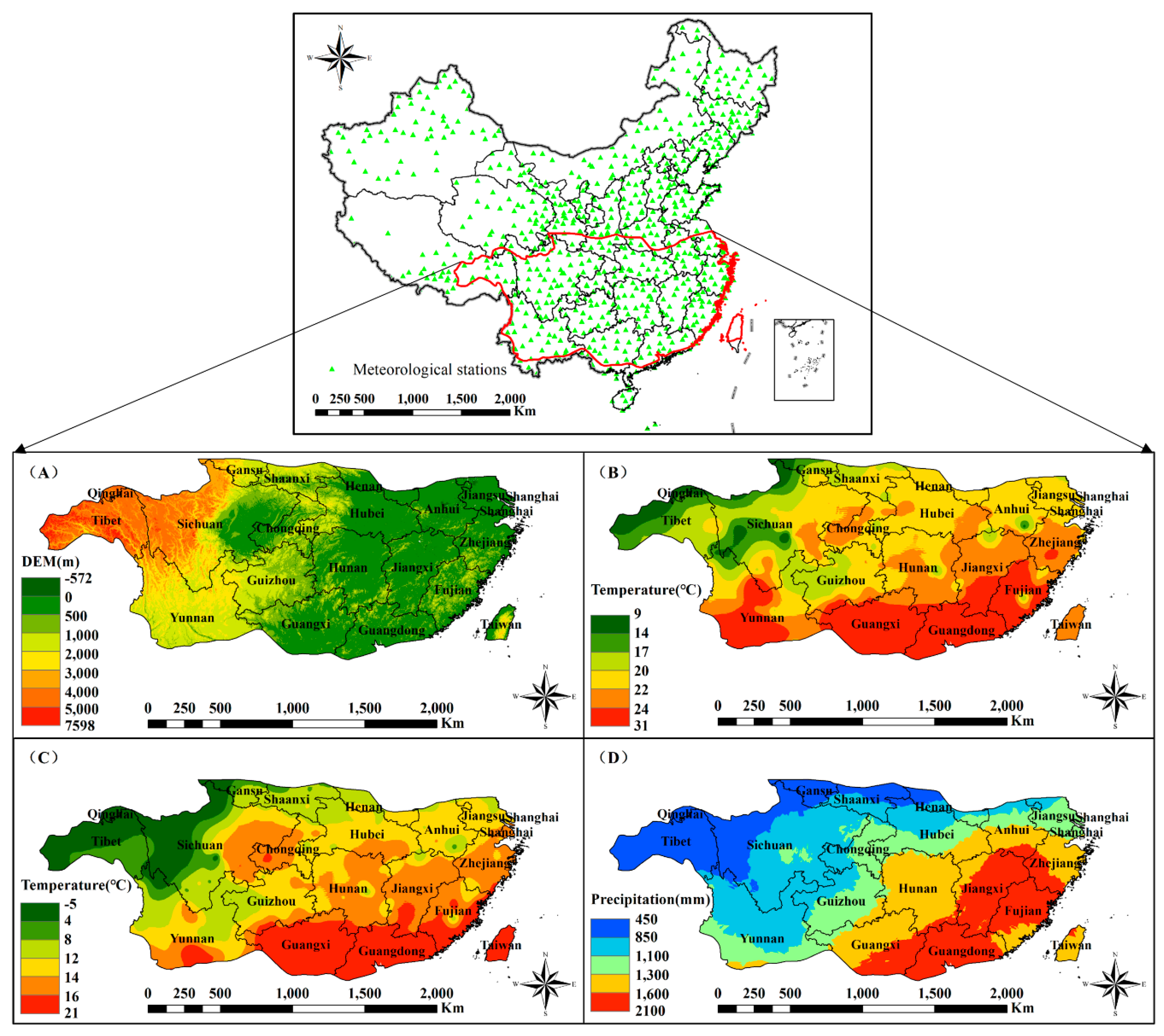
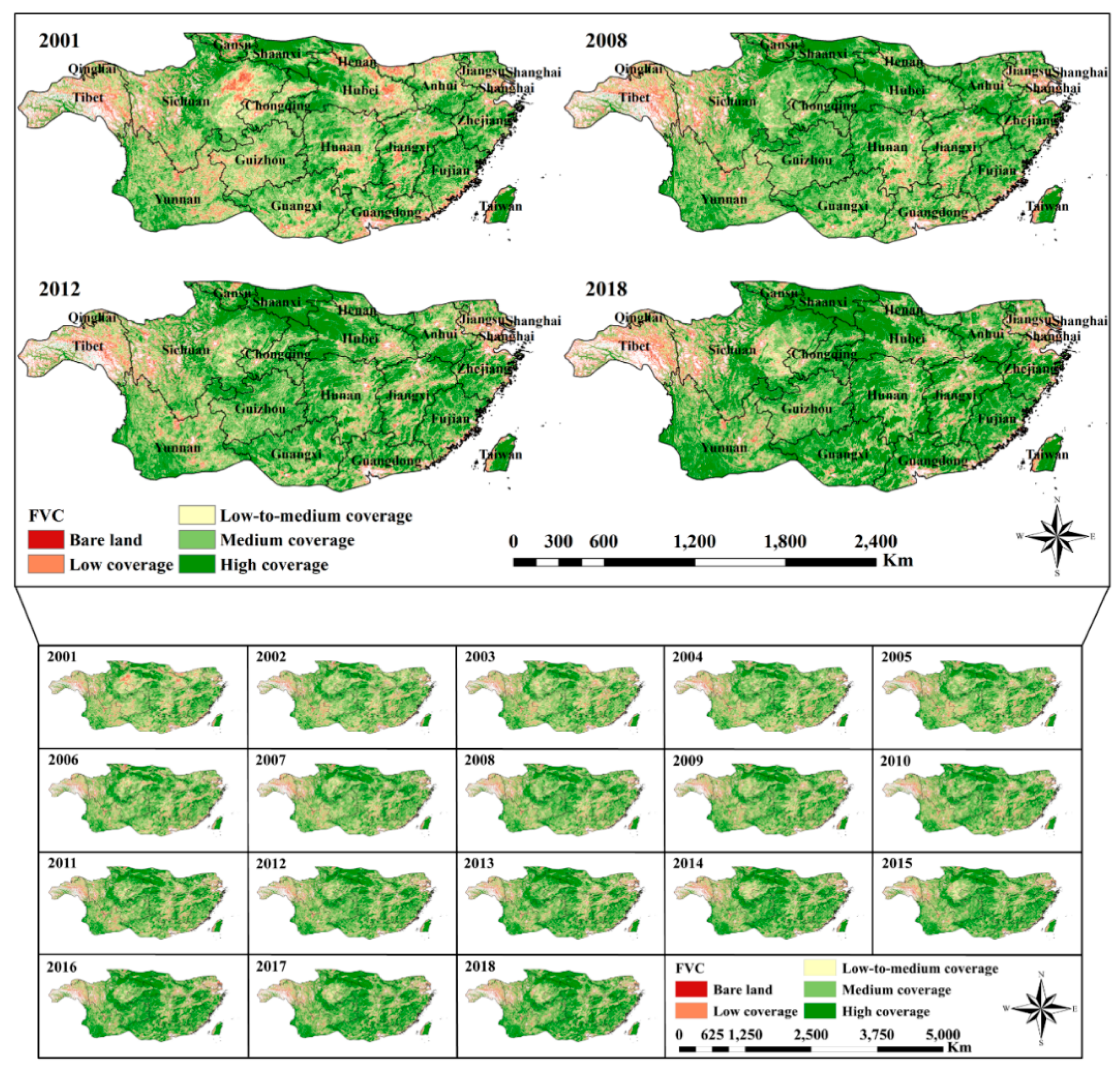
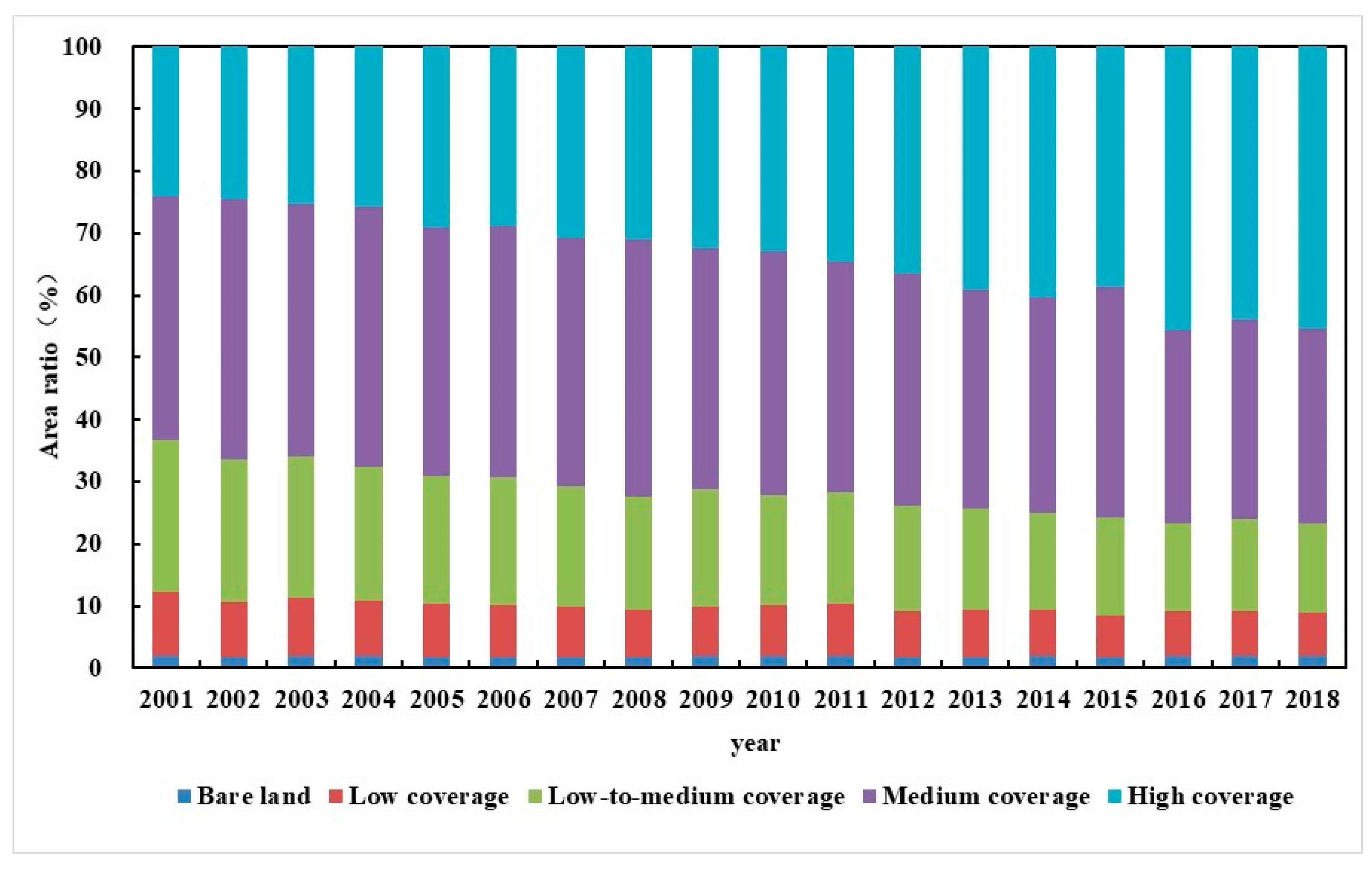
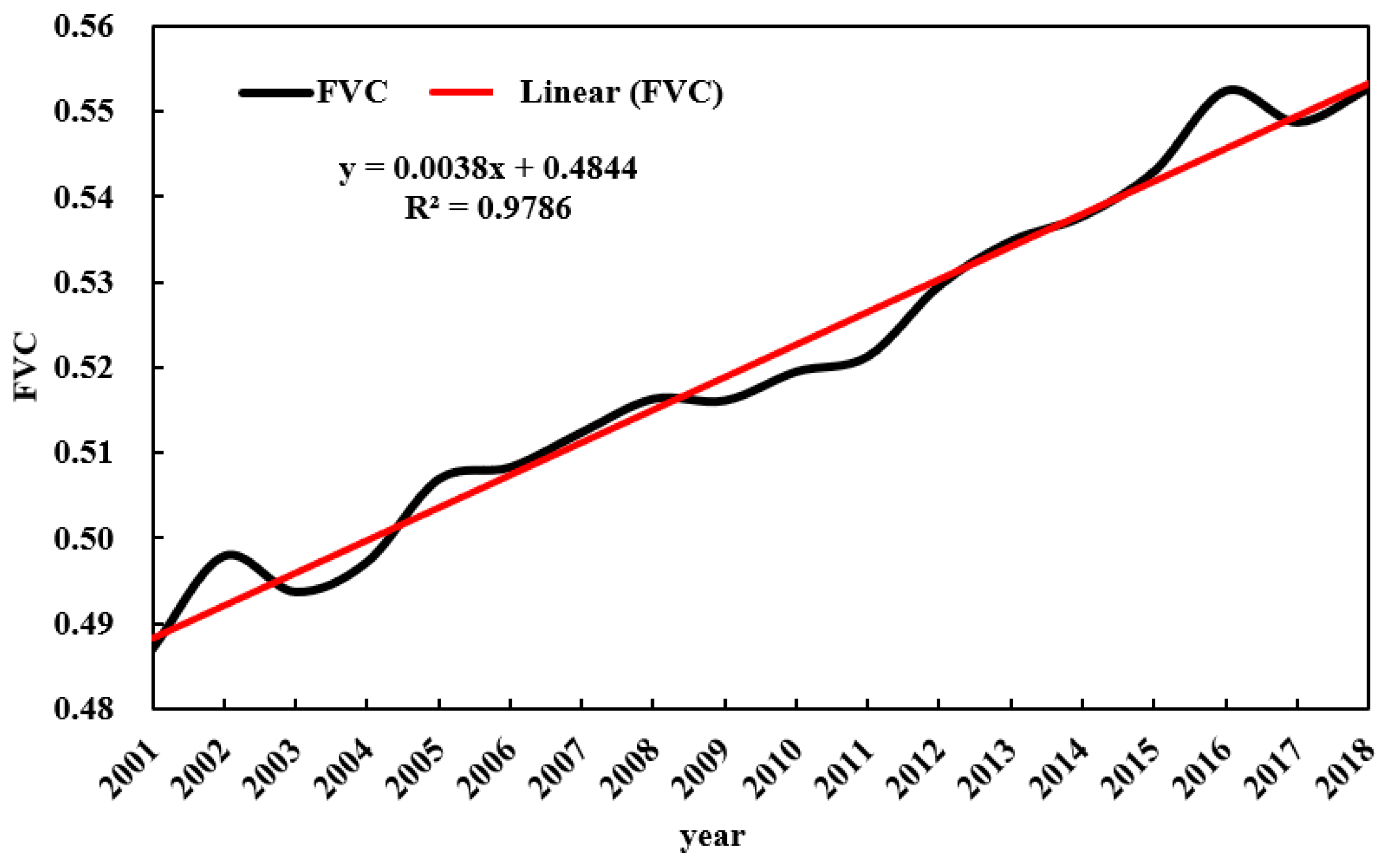

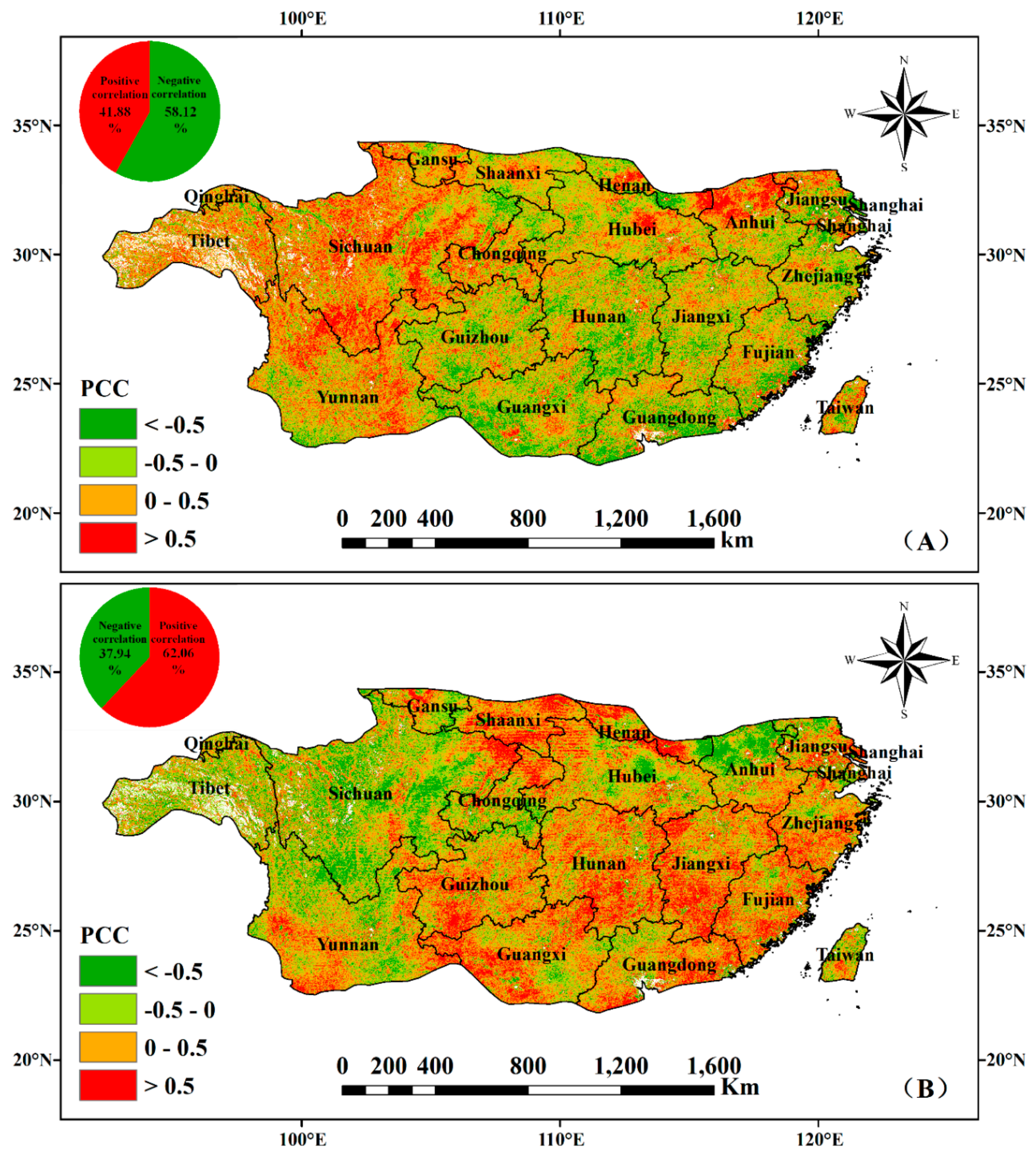
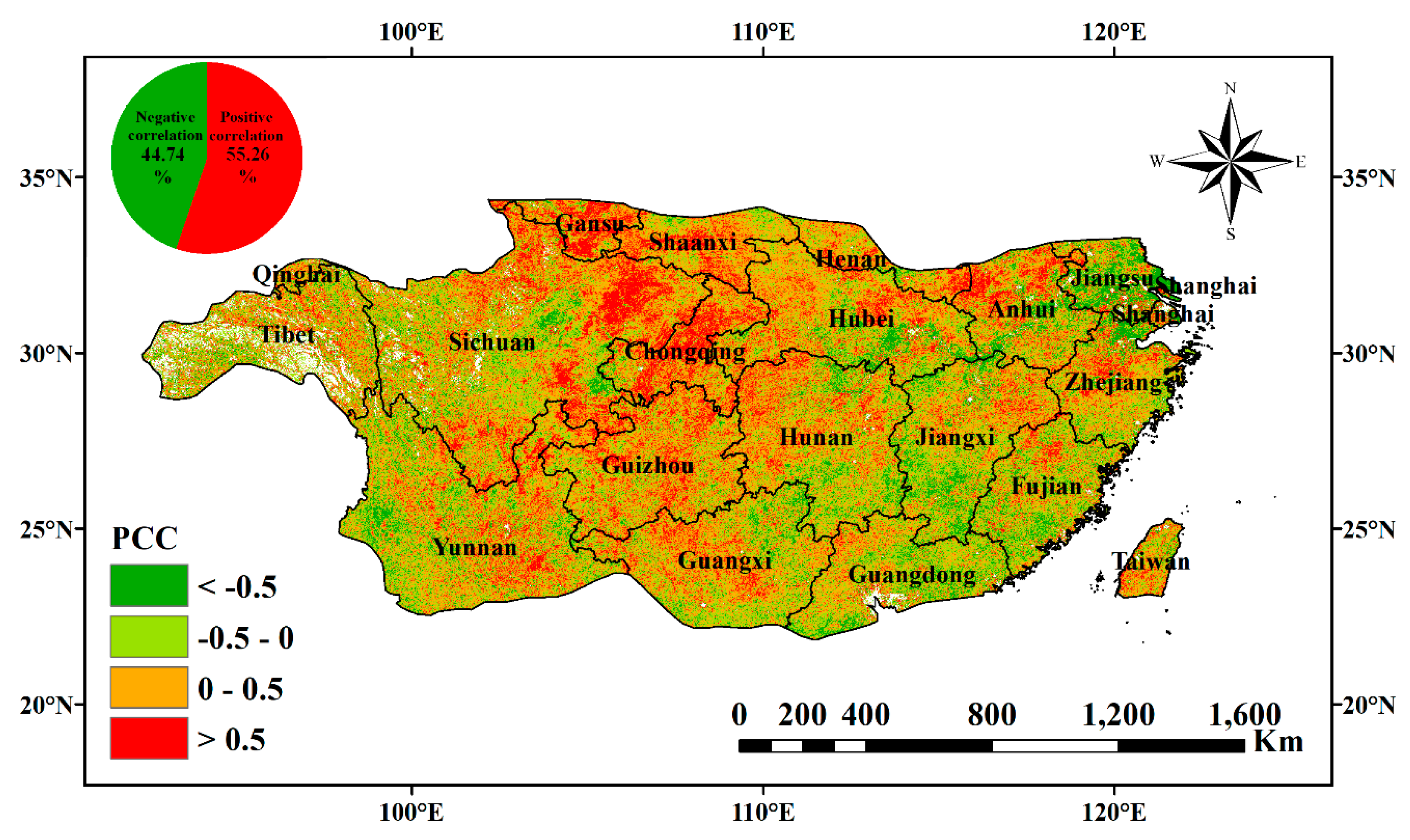
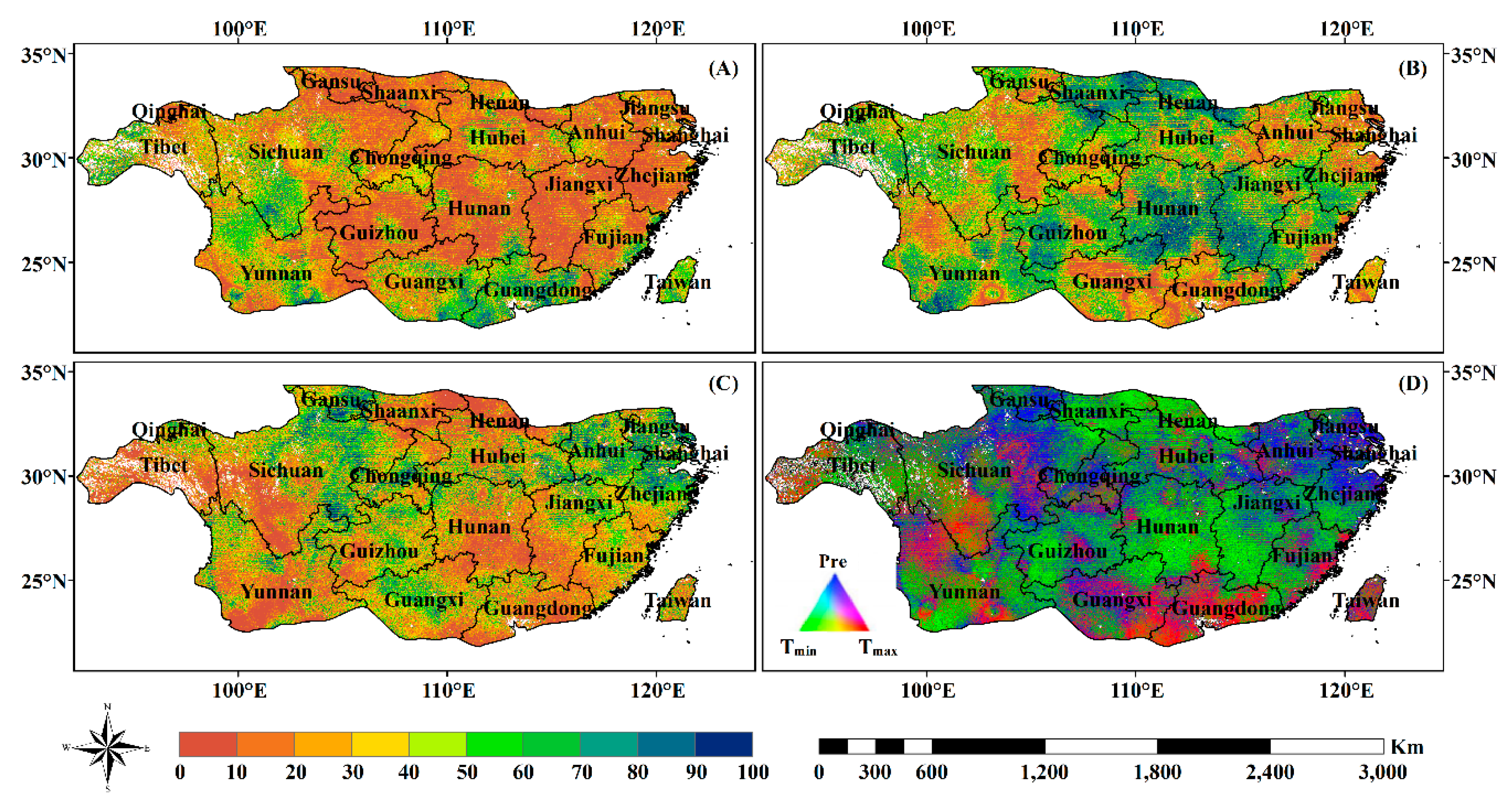
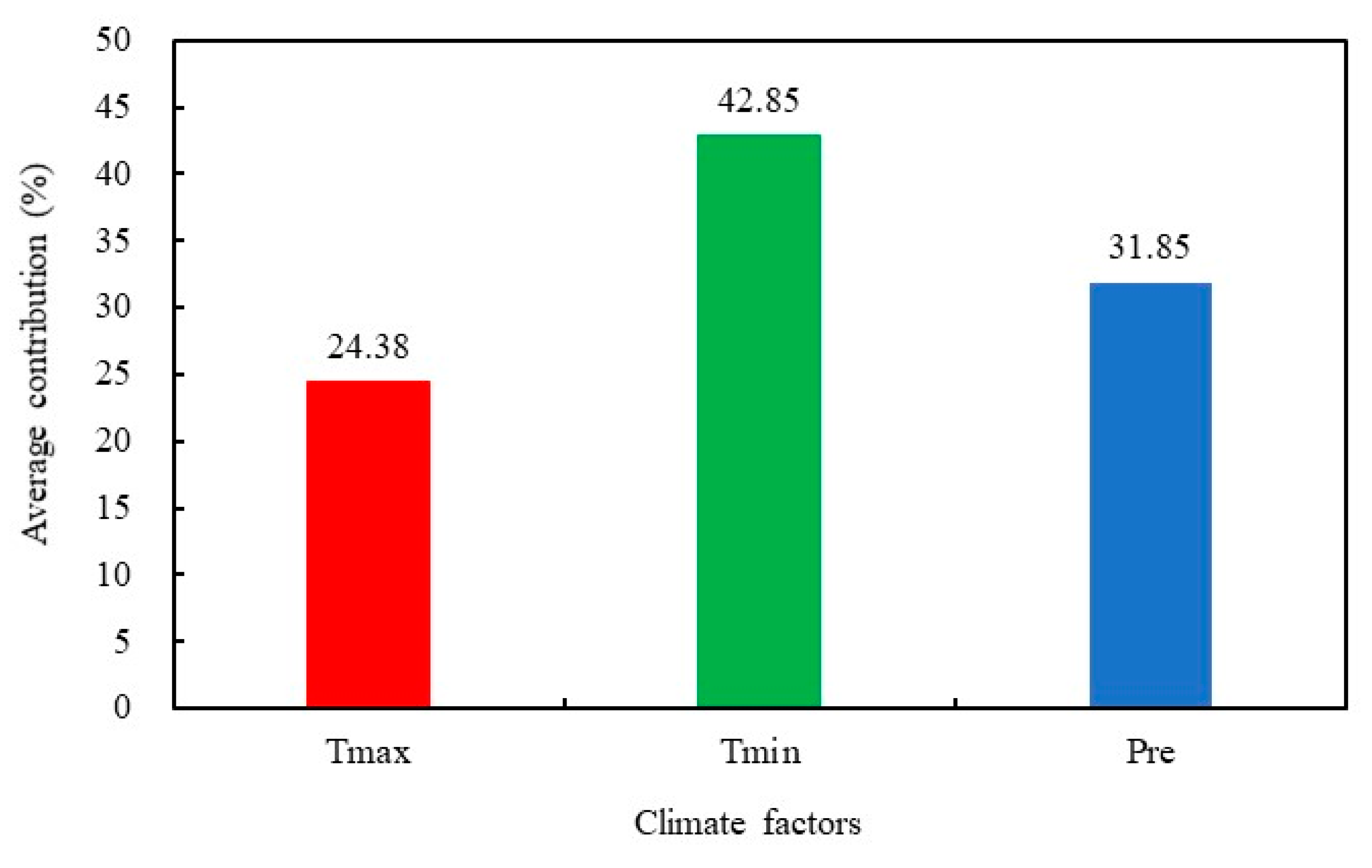
Publisher’s Note: MDPI stays neutral with regard to jurisdictional claims in published maps and institutional affiliations. |
© 2021 by the authors. Licensee MDPI, Basel, Switzerland. This article is an open access article distributed under the terms and conditions of the Creative Commons Attribution (CC BY) license (http://creativecommons.org/licenses/by/4.0/).
Share and Cite
Liu, H.; Li, X.; Mao, F.; Zhang, M.; Zhu, D.; He, S.; Huang, Z.; Du, H. Spatiotemporal Evolution of Fractional Vegetation Cover and Its Response to Climate Change Based on MODIS Data in the Subtropical Region of China. Remote Sens. 2021, 13, 913. https://doi.org/10.3390/rs13050913
Liu H, Li X, Mao F, Zhang M, Zhu D, He S, Huang Z, Du H. Spatiotemporal Evolution of Fractional Vegetation Cover and Its Response to Climate Change Based on MODIS Data in the Subtropical Region of China. Remote Sensing. 2021; 13(5):913. https://doi.org/10.3390/rs13050913
Chicago/Turabian StyleLiu, Hua, Xuejian Li, Fangjie Mao, Meng Zhang, Di’en Zhu, Shaobai He, Zihao Huang, and Huaqiang Du. 2021. "Spatiotemporal Evolution of Fractional Vegetation Cover and Its Response to Climate Change Based on MODIS Data in the Subtropical Region of China" Remote Sensing 13, no. 5: 913. https://doi.org/10.3390/rs13050913






